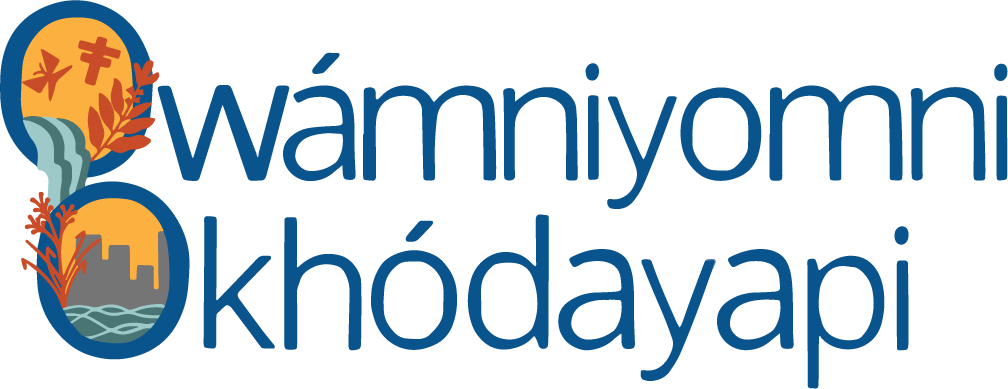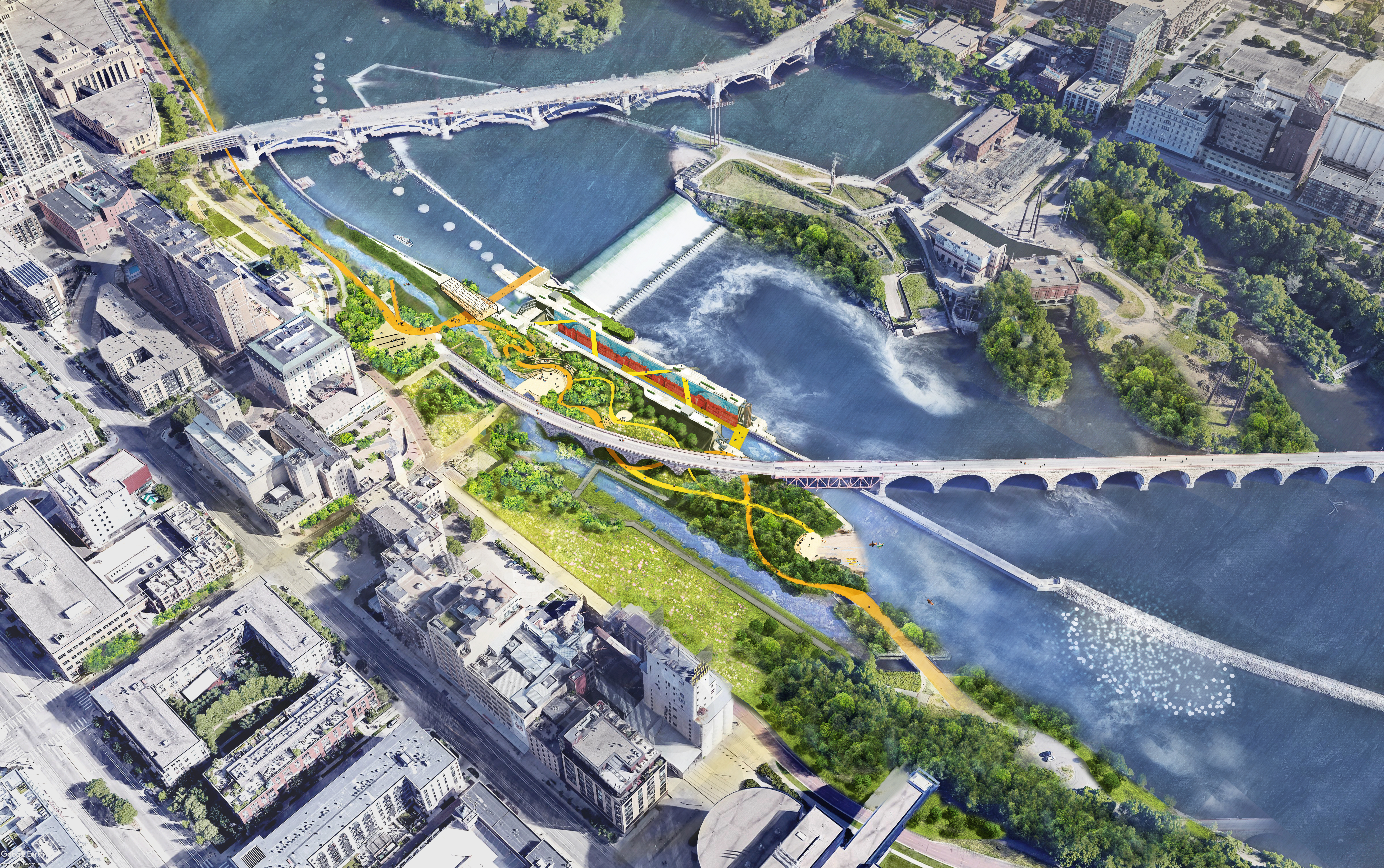Early Design Ideas for Mississippi River Lock & Dam Land Unveiled
Vision Honors Dakota History
Project Transitions to Native Leadership
February 3, 2023 (MINNEAPOLIS) –
Friends of the Falls is unveiling early design ideas for the land adjacent to the St. Anthony Falls Upper Lock and Dam. The group, which formed in 2016 after the U.S. Army Corps of Engineers announced its intention to discontinue use of the lock, has been exploring new uses of the facility and surrounding land. The upper lock, which opened in 1959, closed to commercial navigation to stop invasive species from spreading upriver. It continues to be used for flood control.
The group originally responded to the community’s desire for a world-class visitors’ center to learn about the history of the river, falls and the city. However, after a years-long discovery process, including forums and community input sessions, the group evolved its focus. Friends of the Falls has committed to implementing a Native-led vision for the site, recognizing the cultural significance of the area to the Dakota people and other Native communities who inhabited the land long before the city was established.
Native-led Vision
Early design ideas unveiled today depict gathering places for ceremony and healing, and places to connect physically with the river. Interpretive signage along winding pathways educates people about the historical, cultural, and spiritual significance of the area to the Dakota people.
The designs honor the former site of Spirit Island, a sacred area where Dakota women once came to give birth. The designers also considered ways the lock walls could be utilized to create a gallery for art and education.
The early design ideas depicted in illustrative drawings by GGN, a Seattle-based landscape architectural firm, in partnership with local architect VJAA, were the result of direction from the Native Partnership Council. Friends of the Falls, the Native American Community Development Institute (NACDI), and CDA Enterprises convened the group of elected tribal leaders, Native artists, and elders to set guiding principles for the project. The Council’s vision statement calls for restored connections to the river, honoring Dakota culture and language, and ongoing care for the land and water.
“Members of the Native Partnership Council, tribal communities, and the general public have shared their personal stories and connections to this place. The water is at the heart of them all,” said Kjersti Duval, project director of The Falls Initiative. “The design concepts honor these relationships to the River, while acknowledging the complexities of the site.”
The design is intended to dovetail and complement adjacent Water Works and Mill Ruins parks and is consistent with riverfront plans that the City of Minneapolis and the Park Board have adopted for the area. The drawings do not represent final designs, and the ideas will evolve based on Dakota Tribal leaders’ input and direction.
New Leadership
Founded in 2016 by community leaders Paul Reyelts and Mark Wilson, Friends of the Falls named former Hennepin County Commissioner Mark Andrew as its first president in 2020. Andrew led the project through what is considered the first season of work – initiating the transfer of property from federal to local control, establishing partnerships with the city and park board, building relationships with Native communities, and establishing a vision for Owámniyomni, or St. Anthony Falls.
With the unveiling of early design ideas for the site, Mark Andrew is announcing his retirement, and the leadership team has named Shelley Buck as the organization’s new president. Shelley participated as a leading member of the Native Partnership Council and has served twelve years on the Prairie Island Indian Community Tribal Council, including six years as president.
In addition, with two founding board members retiring, the organization will have a majority of Indigenous members guiding the project forward.
“As this idea evolved, we collectively took a longer-range view of the historical significance of this area and learned that an incredibly important and meaningful part of history was going untold. This is a once-in-a-lifetime opportunity to bring about restoration and healing at a local, regional and national level,” said Mark Andrew, former president, Friends of the Falls. “The time is right to welcome Dakota leadership. Shelley Buck and the board are immensely qualified leaders who can guide this opportunity into reality. They have the full support of the entire community, and I’m proud to have brought the organization to the point where it is transitioning to Native leadership and a Native-majority board of directors.”
“Owámniyomni (St. Anthony Falls) and Wita Wanagi (Spirit Island) were desecrated like so many of our sacred sites. For Friends of the Falls to name a Bdewákaŋtuŋwaŋ (Mdewákaŋtoŋ) Dakota – and in particular a Dakota wíŋyaŋ (woman) – as its next leader, is not a symbolic gesture. It puts Dakota voices rightfully in the lead. The River is our relative; we follow her lead,” said Shelley Buck, president, Friends of the Falls. “In the second season of this project, we will assess different ownership models. It’s our desire to involve Dakota tribal nations in that discussion, to get their input in shaping the vision for the site, and to strengthen their role in the project going forward.”
The City of Minneapolis has agreed to interim ownership of the site, while Friends of the Falls and tribal leaders consider models for long-term ownership.
Timing
Since its inception, Friends of the Falls has secured government and community interest in the project by way of legislation, state grants and various endorsements. Plans for acquisition of land, funding and ongoing management and maintenance are all still in development, and a completion date is estimated to be five to ten years away. Funding is expected to come from both public and private sources, and over $5 million has already been raised to advance the project.
A timeline of The Falls Initiative project milestones is available at: https://thefalls.org/about/#timeline
Illustrative drawings by GGN are available at: https://thefalls.org/design/
Funding for this project was provided by the Minnesota Environment and Natural Resources Trust Fund as recommended by the Legislative-Citizen Commission on Minnesota Resources (LCCMR).



